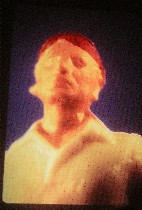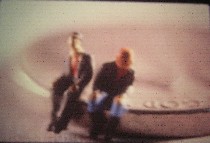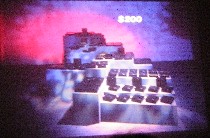(This is part II of a three-part report on Allan McCollum’s talk in this summer’s UArts Brown Bag Lunch Series,”Food for Thought” at the University of the Arts Wednesday. Here’s the previous post.)
McCollum also did a number of collaborations and likes to work that way–with other artists, with studio assistants, with community collaborators. With Laurie Simmons, who was doing dolls and dollhouses, he purchased the smallest cast model-train figures he could find (some Simmons info is here). The artists photographed them and blew them up until the vagaries of the casting process and the hand painting became the subject, rather than the mass-produced perfection that we assume. On that enormous scale, the pieces look unique. There’s an emotional desire to have that mass-produced sameness, but it’s a fiction he said. Every object is unique, even when cast, he said (left above, one of the “Actual Photos,” and right below, a photo showing the scale of the train figures, which are seated on a nickel).
For decent photos of all these projects, try McCollum’s web page. It’s full of really great images and words.
(I’m not so sure this is totally true, although the desire for that kind of control is true. My brother Barry used to manufacture high-tech widgets that had to meet precise specifications. Lack of uniformity would create widget failure. Little, cast figures, however, have no need for that kind of perfection. We do, however, behave as if they achieve that perfection. I suppose at some molecular level, those widgets also might be inconsistent, but it’s their perfection we aim for, wish for and focus on. Well, that is McCollum’s point.)
With Louise Lawler he made a couple of pieces, including “Ideal Setting”–stacks of bases for sculptures. (Here’s some Lawler information.) The bases were of plaster coated with black shoe polish with no sculpture on top. He put them on pedestals in a gallery tricked up like a showroom, with glowing colored spotlights and an inference that the pedestals themselves made art art and in fact were art (Brancusi would have loved this one). Above the stacks, projected on the wall was the price, $200. He said they actually sold one (left, “Ideal Setting”).
One of the collaborations he mentioned was with Andrea Fraser (see post), an artblog favorite, who wrote a script about owning art that the gallery attendants had to memorize and use in talking to people in the gallery. The script highlighted how the sales pitch is also mass produced. Here’s a link to a recent post on Fraser.
In some ways, mass production is the perfect opportunity for collaboration, and McCollum said he likes the social aspect of working with others. While talking about coming from a family with factory work in his and his parents backgrounds, he said it was a pretty good experience for him, and one of the reasons was the comraderie.
(In the last part of this series, McCollum takes his mass production methods and his interest in collaboration to new levels.)









